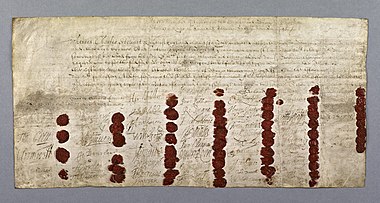
Back Liste der 59 Unterzeichner des Todesurteils gegen König Charles I. German Regicidi di Carlo I d'Inghilterra Italian レジサイド (チャールズ1世) Japanese I. Charles'ın mahkemesindeki hakimler Turkish

Following the trial of King Charles I in January 1649,[b] 59 commissioners (judges) signed his death warrant. They, along with several key associates and numerous court officials, were the subject of punishment following the restoration of the monarchy in 1660 with the coronation of Charles II. Charles I's trial and execution had followed the second English Civil War in which his supporters, Royalist "Cavaliers", were opposed by the Parliamentarian "Roundheads", led by Oliver Cromwell.
With the return of King Charles II, Parliament passed the Indemnity and Oblivion Act (1660), which granted amnesty to those guilty of most crimes committed during the Civil War and the Interregnum. Of those who had been involved in the trial and execution, 104 were specifically excluded from reprieve, although 24 had already died, including Cromwell, John Bradshaw (the judge who was president of the court), and Henry Ireton (a general in the Parliamentary army and Cromwell's son-in-law). They were given a posthumous execution: their remains were exhumed, and they were hanged and beheaded, and their bodies cast into a pit below the gallows. Their heads were placed on spikes at the end of Westminster Hall. Several others were hanged, drawn and quartered, while 19 were imprisoned for life. Property was confiscated from many, and most were barred from holding public office or title again. Twenty-one of those under threat fled England, mostly settling in the Netherlands or Switzerland, although three settled in New England.
There is no agreed definition of who is included in the list of regicides. The Indemnity and Oblivion Act did not use the term either as a definition of the act, or as a label for those involved. "Regicide" has never been a specific crime in English law, and has never been defined in law. Historians have identified different groups of people as being suitable for the name, and some do not include the associates who also faced trial and punishment.
The list has been cited as an early blacklist:[1] the state papers of Charles II (1681) state "If any innocent soul be found in this black list, let him not be offended at me, but consider whether some mistaken principle or interest may not have misled him to vote."[2]
Cite error: There are <ref group=lower-alpha> tags or {{efn}} templates on this page, but the references will not show without a {{reflist|group=lower-alpha}} template or {{notelist}} template (see the help page).
- ^ McFedries 2008, p. 14.
- ^ GB PRO 1921, p. 667.
© MMXXIII Rich X Search. We shall prevail. All rights reserved. Rich X Search